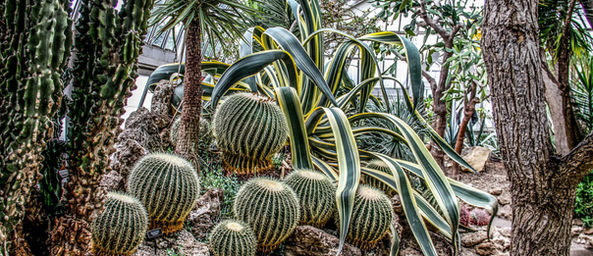Hidden Gems | Read more
Micronesia
* Affiliate links are marked with an asterisk (*). We may earn a commission at no extra cost to you.
Cactus Dome

Where is it?
The Cactus Dome is located on the Pohnpei Island, part of the Federated States of Micronesia in the Pacific Ocean. Pohnpei is one of the four states in Micronesia, known for its lush landscapes, waterfalls, and cultural heritage. The Cactus Dome itself is situated within the Sokehs Ridge area on the island.
What is it?
The Cactus Dome is a unique ecological attraction and botanical garden in Pohnpei, featuring a wide variety of cacti and desert plants. Despite Pohnpei's tropical climate, the dome creates a controlled environment for these plants, which would not naturally thrive in the local climate. The structure is often referred to as a "biome", designed to simulate desert conditions and showcase the fascinating diversity of cacti and succulents from around the world. The Cactus Dome is part of an effort to conserve and promote understanding of plant life in a region where many tropical species thrive but desert plants are rare. Visitors can explore the unique collection of cacti, as well as learn about the environmental conditions that make them special.
Best Time to Visit
Dry Season (December to March): The best time to visit the Cactus Dome is during the dry season, as the weather is typically sunnier, and the conditions are ideal for exploring outdoor attractions in Pohnpei.
Weekdays: Since it's a relatively quiet and serene location, visiting on weekdays will allow for a more peaceful experience.
Tips for the Trip
Dress Appropriately: Given the tropical climate, it is important to wear comfortable clothing and bring sun protection while exploring the area.
Visit Other Pohnpei Attractions: The island is also home to other natural wonders such as Nan Madol, a mysterious ancient ruin, and several waterfalls, making it worthwhile to explore more of Pohnpei’s unique environment.
Guided Tours: To fully appreciate the significance of the Cactus Dome and its diverse plant collection, consider joining a guided tour to learn more about the desert plants and the efforts behind their cultivation in such an unexpected location.
-
Whether you're looking for accommodation, flights, rental cars, activities, or a complete travel package – it's easy to compare and organize everything in one place. You can find and book everything on Expedia *
Jellyfish Lake

Photo by Richard Schneider https://www.flickr.com/photos/picturecorrect/14416212092
Where is it?
Jellyfish Lake, also known as Ongeim’l Tketau, is located on Eil Malk Island, part of the Rock Islands in the Pacific nation of Palau. Palau is situated in Micronesia, a region in the western Pacific Ocean. Eil Malk Island is part of a UNESCO World Heritage Site and is a short boat ride from the country's main island, Koror.
What is it?
Jellyfish Lake is a marine lake famous for its unique population of golden jellyfish (Mastigias papua etpisoni), which have evolved to lose their stinging ability due to the absence of natural predators in the lake. This rare phenomenon has made the lake one of the world’s most extraordinary snorkeling destinations.
Key features of Jellyfish Lake include:
Golden Jellyfish: The lake is home to millions of golden jellyfish, which migrate across the lake daily, following the sun’s movement to support the photosynthetic algae that live inside their bodies and provide them with nutrients.
Non-Stinging Jellyfish: Over millennia of isolation from the ocean, the jellyfish have adapted to their predator-free environment, losing much of their ability to sting, making it safe for humans to swim among them.
Marine Lake: Jellyfish Lake is one of approximately 70 marine lakes found in Palau, but it is the most famous due to its high concentration of jellyfish and its accessibility to visitors.
Unique Ecosystem: The lake is connected to the ocean through fissures and tunnels in the limestone, but it is otherwise isolated, creating a distinct ecosystem that is different from the surrounding marine environment.
Snorkeling in Jellyfish Lake offers an unforgettable experience of swimming through a mesmerizing swarm of golden jellyfish in crystal-clear water. However, scuba diving is not permitted to protect the lake’s delicate ecosystem and avoid stirring up harmful layers of hydrogen sulfide present at deeper levels of the lake.
Best Time to Visit
Dry Season (November to April): The best time to visit Jellyfish Lake is during Palau's dry season, when the weather is sunny, and water visibility is excellent. During this period, the jellyfish population is at its peak, providing a more vibrant experience.
Avoid Wet Season (May to October): While still accessible, the wet season brings heavier rainfall and reduced visibility in the lake, which might affect the overall experience.
Tips for the Trip
Permits Required: To visit Jellyfish Lake, you'll need to obtain a Rock Island Permit, which grants access to the lake and other parts of the Rock Islands. Permits can usually be arranged through tour operators.
Snorkeling Gear: Bring or rent snorkeling gear to fully enjoy the experience. Snorkeling is the only way to explore the lake, as scuba diving is not allowed.
Eco-Friendly Practices: Use reef-safe sunscreen or avoid sunscreen entirely to protect the lake's fragile ecosystem.
Respect Conservation Efforts: Follow the guidelines provided by local authorities to ensure the preservation of the lake and its unique inhabitants.
Guided Tours: Consider booking a guided tour to learn more about the lake’s ecology and history. Guides often provide interesting insights into the evolution of the jellyfish and the lake’s geological background.
